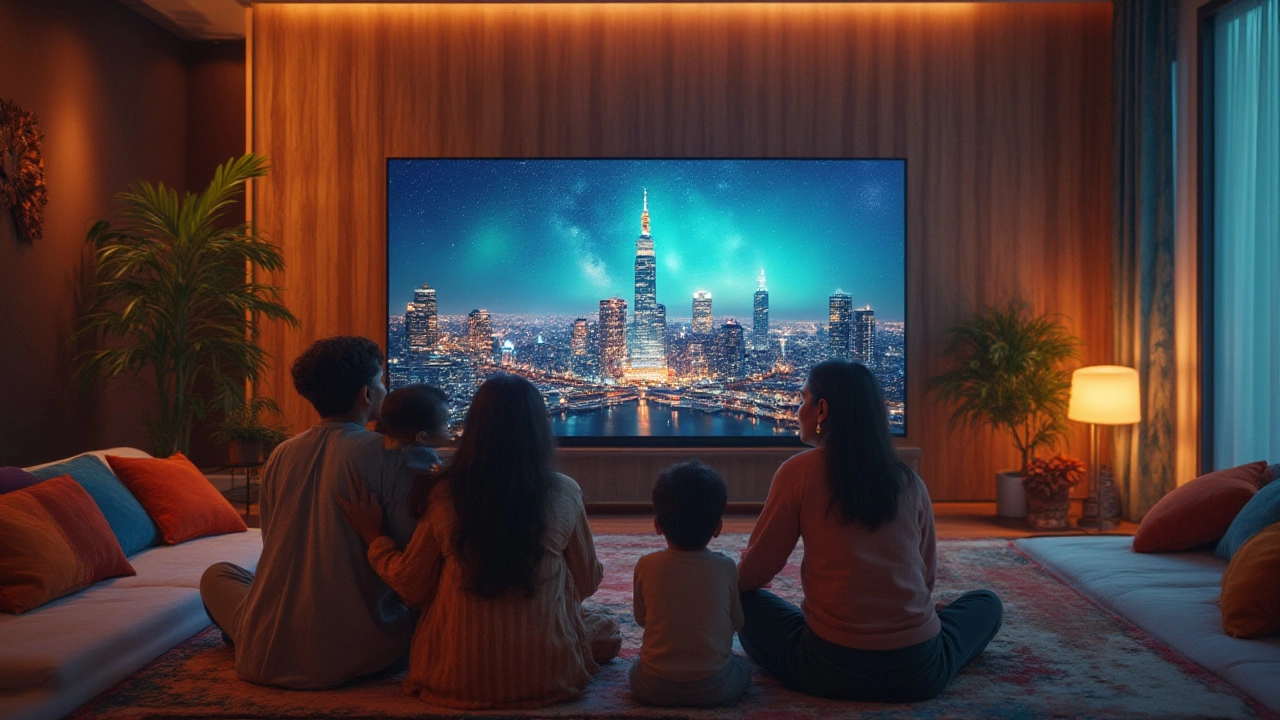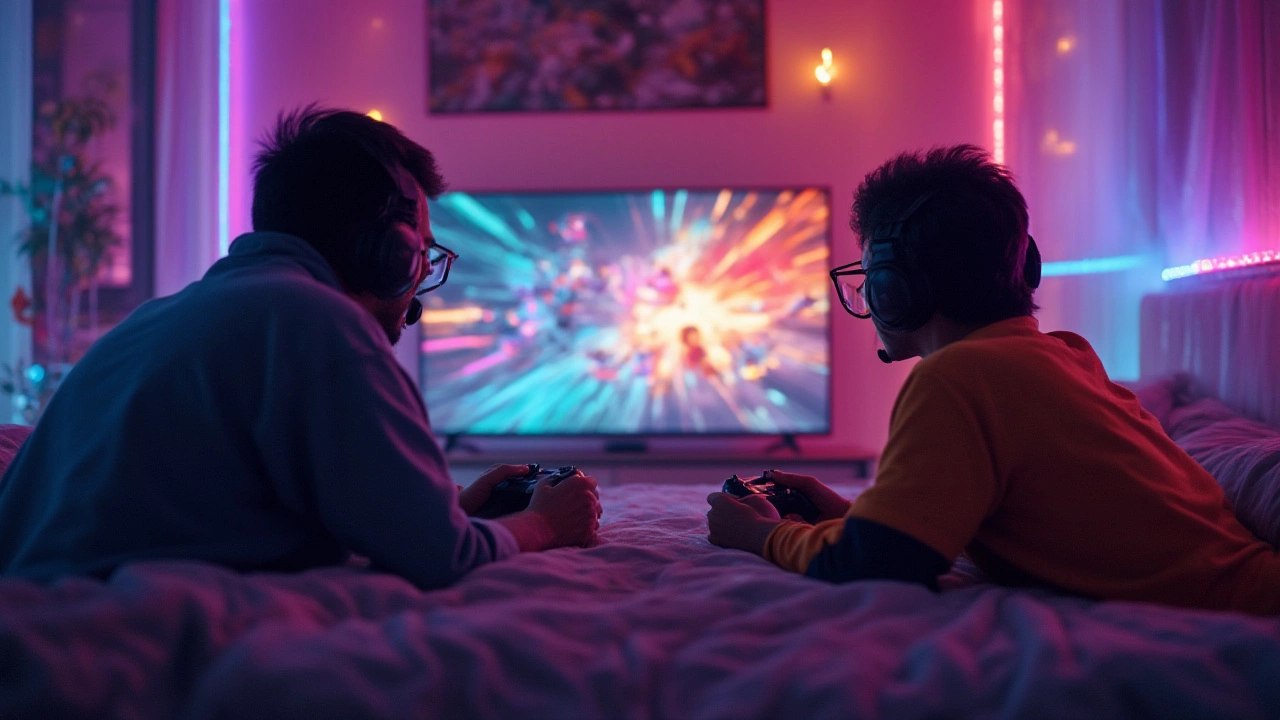
Imagine buying a TV for the first time in years and facing a store wall glowing with a rainbow of options—a dizzying display of features and specs. There’s a fast-talking salesperson praising 8K QLED sets “for the future,” while another whispers about 4K OLEDs with “real black levels.” Which do you actually want in your living room? Here’s the deal: under all the hype, the difference can be game-changing—depending on what you want from your TV and how you use it.
Breaking Down the Basics: What’s 8K QLED and 4K OLED?
Let’s get the technical stuff out of the way so we’re all on the same page. QLED stands for Quantum-dot Light Emitting Diode. It’s basically an LED TV jazzed up by a layer of quantum dots that boost color and brightness. When you see “8K QLED,” that means this TV has a crazy-sharp 7680 x 4320 pixel resolution—about four times more dots than a 4K TV, which already looks sharper than most people ever expected. Trust me, I thought 1080p was amazing ten years ago—now 8K makes it look like Minecraft.
Now, OLED means Organic Light Emitting Diode. Each pixel here is its own light source—that’s the magic. When a pixel needs to be black, it turns off completely. So what do you get? Oozing-deep black levels, wild contrast, and colors that feel fresh from an art student’s palette. Most OLEDs you’ll find top out at 4K—3840 by 2160 pixels. Lower resolution than 8K, but thanks to the way colors and blacks are handled, the picture just pops in dark rooms. It’s almost hypnotic when you’re watching movies like "Blade Runner 2049" or a moody horror show after midnight.
But that’s not the whole story; there’s plenty more lurking beneath the tech names on those flashy boxes. The type of backlighting, material costs, processing, and even the remote controls can change your daily experience. It’s not just about watching—every pet owner with a dog named Max or a cat like Luna will tell you, the details you see (or miss) change the way your favorite animal videos feel. With Max’s fur or Luna’s whiskers in 8K or with OLED-level contrast, it’s a wild transformation.
Picture Quality Face-Off: Pixels, Brightness, and Color
If you want to set off never-ending social media debates, ask whether more pixels matter over deeper blacks. Let’s get into it: 8K QLEDs win the numbers game. You’ve got quadruple the pixels over 4K—meaning images stay sharp even at massive TV sizes. On paper, 8K is unbeatable for people who sit super close to their screen or crave the sharpest visuals possible, like in an 85-inch TV set up in a tight living room.
But here’s the catch: real 8K content is scarce. Netflix, YouTube, and Disney+ don’t pump out much in native 8K yet. Most of what you see is upscaled—AI magic tries to fill in the extra pixels from lower-res content. Sometimes it looks great, sometimes it looks a little odd, especially for old content. Still, if you want a "future-proof" display, 8K QLED feels ready for the next decade (or until the next tech format war begins).
OLED flips the script. Instead of brute-forcing resolution, it dazzles with precision lighting. Every individual pixel can be totally off, which creates flawless blacks and infinite contrast ratios. A 4K OLED might not have the pixel count of 8K, but its contrast and color accuracy are jaw-dropping. Your dark scenes look like cinema-quality perfection, and HDR pops with more intensity. Watch "The Mandalorian" with all the lights off, and it’s like you’re in the middle of a galactic gunfight.
Brightness is another wild card. QLED panels can get blindingly bright—think sunlight streaming in on a Sunday afternoon, and you still see everything. OLEDs can’t compete with that daylight punch and sometimes suffer from “auto-brightness limiters” that dull the screen during a big, bright scene. But at night? OLED is king for subtle gradations and pure blacks, making every scene feel cinematic.
Check this table for a clear breakdown between the two technologies:
| Feature | 8K QLED | 4K OLED |
|---|---|---|
| Resolution | 7680 x 4320 | 3840 x 2160 |
| Peak Brightness | Up to 4000 nits (some models) | 800 – 1000 nits (most models) |
| Contrast Ratio | Very high (but limited by backlight) | Infinite (each pixel can be totally off) |
| Color Volume | Excellent (wide color gamuts) | Outstanding (perfect blacks help perceived colors) |
| Black Levels | Improved (local dimming) | Perfect (individual pixel control) |
| Content Availability | Limited native 8K content, great upscaling | Plenty of 4K streaming and Blu-ray |

Gaming, Movies, and Everyday Use: Which TV Wins?
Let’s be honest—most of us don’t just watch wildlife documentaries and demo reels. You’re switching between games, sports, 3 a.m. YouTube rabbit holes, and the occasional movie night. Does the TV tech actually change that much? Absolutely, if you know what to look for.
Gamers chase response times and motion clarity. OLED leads here, no question. The way those screens control each pixel means next to zero motion blur and instant response—imagine swinging the camera in "Spider-Man: Miles Morales" and everything staying razor sharp. Most high-end OLEDs also support HDMI 2.1, variable refresh rate (VRR), and 120Hz gaming. But some QLEDs push even higher frame rates or add gaming-specific features like auto low latency mode. The QLED camp might not have those OLED-black levels, but they’re less likely to face burn-in if you leave the same HUD on screen for hours. Though, let’s be real, burn-in is mostly an issue for people watching 24/7 news with fixed banners, not your average console fan.
For movie lovers, OLED is the sweet spot—for now. That mega contrast ratio makes film noir, space epics, or horror movies really stand out. Filmmakers often choose OLEDs as reference monitors for this reason. If you’re into visual details—watching subtle shading or catching that glimmer in a villain’s eye—OLED is unmatched. But, if you watch with all the lights blazing and need a screen that cuts through glare, 8K QLED’s brightness is your best friend.
Sports fans and the daily binge-watcher crowd have different needs. Reflections and glare are less of a problem on QLEDs; OLED panels are more reflective by nature. QLEDs are usually available in bigger sizes (think 85 inches and up), while OLEDs start small and top out in the 77 to 83-inch range for regular folks. That’s handy when you want to watch with the entire family—or, if you’re like me, with an overenthusiastic dog jumping up at every replay!
Sound matters too. Both technologies have improved speakers, some hiding subwoofers behind razor-thin panels or using clever sound-projecting tricks. But most buyers (like me) end up with a separate soundbar or surround system, so it’s fine not to obsess over built-in audio too much.
How Longevity, Burn-In, and Practicality Stack Up
Buyers always want to know: is this thing going to last, or is it going to fail right when the warranty’s up? QLEDs tend to be hardy beasts. Since it’s an evolved LED-backlit tech, the parts are well-tested, and brightness doesn’t naturally fade dramatically over time. No real risk of burn-in, either—you can leave news tickers or game HUDs up for years without ghost images haunting your screen. That gives the edge to QLED if you want to use the TV like a digital noticeboard or for marathon gaming.
OLEDs have improved a lot. The early days saw actual cases of burn-in—where static logos or HUDs would “shadow” the panel forever. TV makers are way better at fixing this with screen shifters and pixel refresh cycles now. For the average household, burn-in isn’t a life-or-death worry. I’ve had my 2021 OLED going almost non-stop in the background for two years, binging shows while Max and Luna ignore the screen, and I’ve seen nothing weird yet. If you’re using it for constant sports with fixed scoreboards or are super picky, maybe stick to QLED. But for movies, games, or daily series, OLED holds up just fine with some care.
Both types come with smart features—voice control, streaming apps galore—though settings can get complex fast. OLEDs are often thinner, lighter, and wall-friendly. QLEDs might weigh more, but sometimes that stands for ruggedness (or for withstanding a playful feline launch, in my experience).
Prices matter. 8K QLEDs cost more, especially for screen sizes large enough to make all those pixels count. They’re among the priciest sets in stores, although prices are dropping year by year. 4K OLEDs start closer to "premium" but less "luxury yacht"—and sales often make them competitive with flagship QLEDs. If you want the look of tomorrow’s tech today, expect to pay for it.

Choosing the Right TV for You: Tips, Pitfalls, and Real-World Advice
Feeling overwhelmed? You’re not alone. Here are some hard-won tips—after testing sets, reading too many forums, and getting chewed on by Max for ignoring him too long:
- If your room gets a ton of direct sunlight, or you love mega TV sizes (over 80 inches), 8K QLED is worth your shortlist.
- For midnight movie marathons in a dark room or anyone obsessed with color depth, 4K OLED can make everything look glorious.
- Only super sharp-eyed viewers sitting very close will notice the full effect of 8K at normal TV sizes. Most 8K content is upscaled anyway.
- If you’re a hardcore gamer who leaves game elements on the screen 24/7, lean towards QLED. If you mix it up, OLED’s response time is a joy.
- Consider how long you plan to keep the TV. If you swap sets every four or five years, future-proofing might matter less than enjoying better blacks right now.
- Don’t get stuck on one metric—test both styles in a store with your own eyes. Bring the family along and play the kind of shows you watch most.
And here’s a cool trick: pull up brightly lit nature scenes or videos of dark, starry nights in the showroom. Look for banding, black levels, and color accuracy instead of just gawking at the demo loop. Sometimes TV settings on display units are jacked up unrealistically, so ask staff to switch to “movie” or “natural” mode for a real-world view.
If you want my advice—having lived with both—it really comes down to your habits and your setup. For pure "wow" factor in normal living rooms, most people are floored by the contrast and immersion of 4K OLEDs right now. But if you want to pick a side for the future, brag about pixel counts, or overcome daylight glare, a 8K QLED TV could edge in.
Technology keeps marching forward. Maybe soon we’ll tell our pets stories about the "old days" of 4K versus 8K, and they’ll roll their eyes just like we do at VHS tapes. Until then, choose the tech that lights up your shows, games, and daily life—with or without Max growling every time someone knocks on the TV’s doorbell.